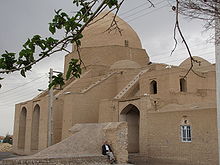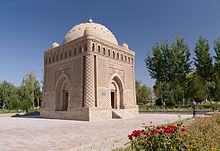Razi style
The Razi style ( Persian سبک رازی, sæbk ɛ ɾɑzi ) is a traditional Iranian architectural style . In chronological order it is the fourth Iranian architectural style after the Parsi, Parti and Khorassani styles . Although it originally came from northern Iran, it developed in Rey , where the most outstanding buildings come from. Looting by Mahmud of Ghazni in the 11th century led to their destruction.
The architectural style developed in the Ziyarid era and continued to develop during the Bujid , Seljuq, and Salghurid era up to the Khorezm Shah era . Towards the end of that era, buildings were built whose appearance is similar to the Razi style. Worth mentioning are the Samanid Mausoleum , the Arsalan Dschaseb Mausoleum and the Ayaz Minaret , which are considered to be the links between both styles.
In the Razi style, buildings with various functions, such as burial towers and mile, were built. The burial towers were mostly square, pentagonal (e.g. Baba Rokn ed-Din mausoleum in Isfahan), hexagonal, octagonal, cylindrical , simple or toothed ( e.g. Gonbad-e Qabus ). In Turanposht in Yazd Province there are the pentagonal and hexagonal towers.
Some mosques, with pillars in their shabestans , were converted into four-iwan courtyards . The iwan is a room that dates from the pre-Islamic period and was rediscovered in the Razi style. The pillars near the mihrab and in the middle were removed. An example of this is the Friday Mosque of Isfahan , which had a shabestan with columns according to the former plan, created in the Khorassani style. Another example is the Ardestan Friday Mosque . Some suspect that the Saware Friday Mosque was the first mosque to be converted into a four-iwan courtyard mosque, but research shows that it had previously been constructed differently.
More examples of the Razi style:
- Charaghan tombs
- Friday mosque by Zaware
- Gonbad-e-Sorch
- Rebat-e-Sharaf
See also
Individual evidence
- ↑ a b c d Mohammad Karim Pirnia: Gholamhosseyn Memarian (Ed.): Sabkschenāssi ye Memāri e Irāni (The Stylistic Study of Iranian Architecture) ( Persian ). Sorush-e-Danesh, 2007, ISBN 964-96113-2-0 , p. 158.


